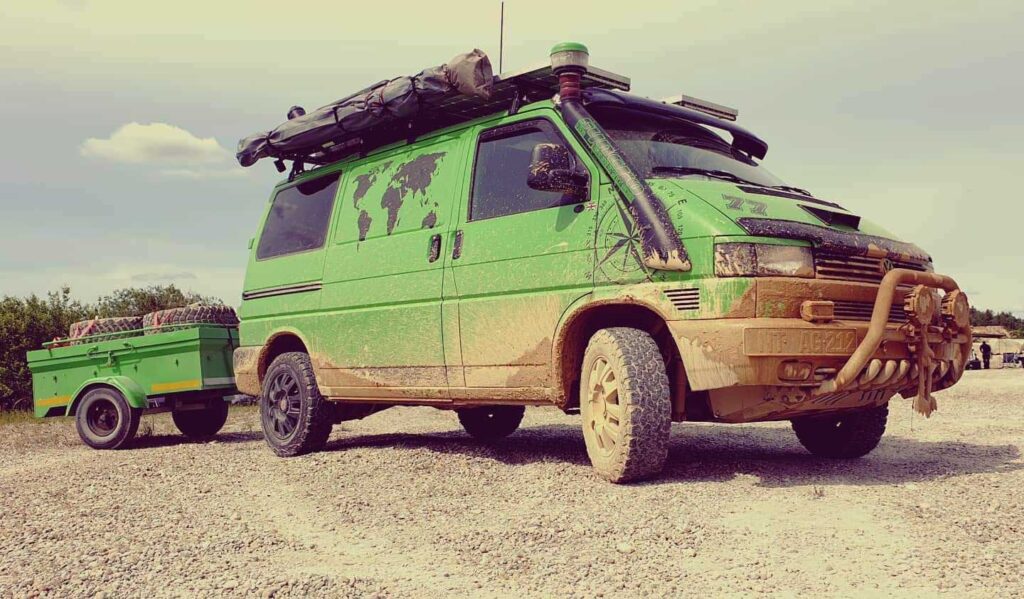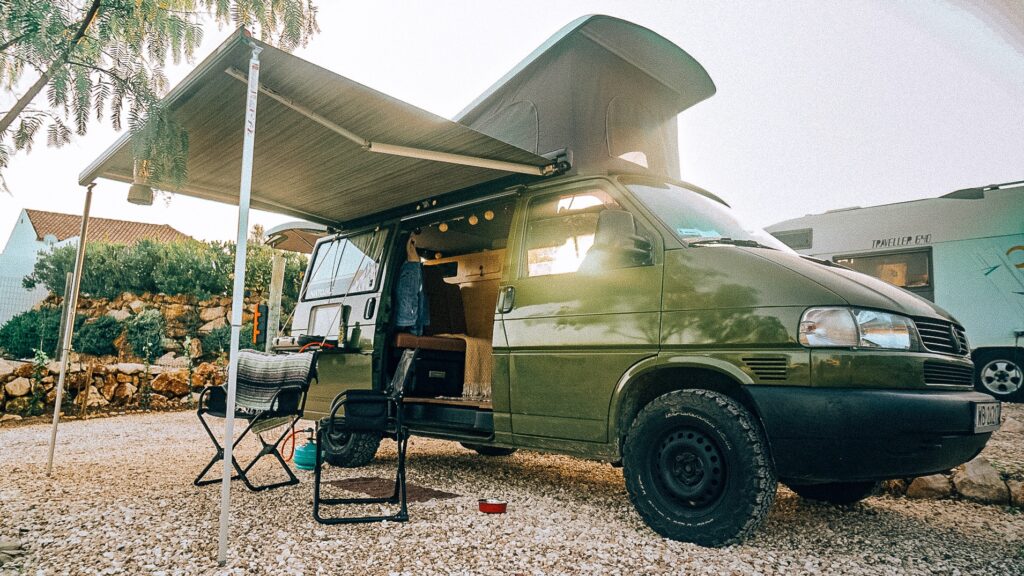






Images thanks to green-syncro and nato.bus
The idea of a compact off-road compact van sounds appealing, especially when converted to a wild campervan. The VW t4 Syncro blends the car like VW T4 chassis comfort with the robust and rugged Syncro all-wheel-drive system.
Volkswagen’s VW t4 Syncro replaced the much loved T3 model. The T4 Syncro model was lunched to a hesitant marketplace which had become accustomed to the seeing the mighty T3 Syncro model tacking impossible terrain. Volkswagen had released a full range of Syncro body types with engines including 2.4D, 2.5Tdi and 2.5 petrol taking over from the esteemed VW T3 Syncro which remained in production a full two years after the full T3 range was redrawn.
The T3 Syncro had built a reputation for its simplicity and ruggedness. Something that the car like VW T4 had to prove in some markets before being widely accepted.
Volkswagen’s T4 design was also a considerable departer from that of the T3, gone was the rear engine which had become a trade market of VW Transporter range. The Volkswagen T4 was the beginning of a modern generation of vehicles which draw some raised eyebrows for customers used to rear-engined Volkswagens.
What is Syncro?
The Syncro permanent all-wheel-drive system is known as the ‘intelligent’ automatic all-terrain four-wheel drive. Unlike the Quattro system found in Audi’s of the time, Volkswagen’s 4WD system reacted to the terrain conditions and automatically delivered drive to the wheel with the most traction. In contrast, the Audi Quattro configuration responded to the driver’s input and had a mechanical centre differential.
The Volkswagen Syncro had been available since the 1980s, appearing in the Golf Country, sporting Rallye Golf, Golf G60 Limited and of course the T3 Syncro. The system could trace its roots back to military developed for World Two and was by the 1990s a technically proficient permanent all-wheel-drive system.
VW T4
The Volkswagen T4 was a genuinely new platform when introduced in 1990; replacing a basic formula which has served VW since the Type 1 in the 1950s with an engine positioned at the rear.
Development of the new generation of Volkswagen vans started in the early 1980s, with development work beginning in 1982 and an initial prototype presented in 1983. These early days focused on establishing the ideal longitudinal vs transverse engine configuration. It wasn’t until 1986 that the T4 as we now know it started to take shape.
This new class of van was to be as comfortable as a car in the form of the Caravelle and feature a flatbed load bed for use as a commercial panel van, Eurovan, Kombi, single and double cab pickup and Syncro. By 1987 the engineers at Volkswagen had established the perfect engine and suspension configuration. On agreeing on the principles for the chassis arrangement, Volkswagen’s designers ‘progressed quickly’ with the bodywork with the completed VW T4 being presented for sale some three years later.
Unlike the T3 which was only available with a fixed chassis length, the VW T4 introduced a number of design improvements. The fourth-generation transporter was available either in short or long-wheelbase forms. The rear doors were for the first time offered in tailgate or barn door configuration and to the delight of anybody needing clear access to the rear load area, the VW transporter load-deck was now much lower to the ground with the engine being moved to the front rather than awkwardly positioned at the rear.
Volkswagen’s T4 was a sales success, selling in a wide range of body types and engine configurations. Diesel and petrol engines, with even a sporty 2.8 150kW; 201bhp VR6 starring in the range, there was a new VW transporter for every taste.
Syncro camper
Volkswagen produced a rare Exclusive California featuring VW Syncro; there is not a lot of information available about this specific model due to its limited production other than the fact that it was a long-wheelbase configuration. A Syncro California would have been expensive purchase, which may account for its limited production numbers and lack of information.
The Syncro campervan is a highly desirable configuration; if you are searching to purchase a Syncro, you are most likely to find converted campervans which use a commercial or Caravelle van as their base. These vans provide a robust platform to develop a suitable campervan with the go-anywhere ability for wild camping. Being a Syncro at heart, these campervans are perfect for taking off the regular track into the wilderness.
With a passionate community of owners, the VW Syncro has inspired may VW T4 owners to add all-terrain tyres to there conventional two-wheel drive Veedubs, a popular style called the Swamper look. A class which has taken its name from the US term for ‘native or inhabitant of a swampy region’.
Servicing a VW T4 Syncro
The Syncro system seems to be relatively reliable and robust; however, from my brief online research, it appears that the viscous coupling used to transfer power within the 4WD system seems to be a weak link. The viscous coupling designed to last just 100,000kms (about 65,000 miles) with Volkswagen charging GBP 2,500 to replace this vital part; the good news here is that there is an aftermarket solution. An excellent place to find out more information about the specific Syncro issues is the VW T4 Syncro owner’s page.
Having owned a VW T4 myself for several years, and restored it from a tired rust bucket. My advise when purchasing any VW of this age is check and recheck for corrosion. Located in the UK, living near the ocean are all good ingredients in helping VW corrosion. The particular areas for VW T4s rust are around wheel arches, sills and surrounding the windshield/windscreen. I also found that above the sliding door and step are prone to decay.
All engines are relatively reliable. The diesel 2.4d is basic and slow, can be absurdly run on used cooking oil and is known for being bulletproof reliable. Petrol engines are not as popular as diesel; they are thirsty and offer little advantage. Volkswagen’s best all-round option being the more modern 2.5tdi. To confuse matters, the Turbocharged Direct Injection engine comes in three flavours; (65kW 87bhp), (75 kW; 101 bhp) and rare to find (111 kW; 149 bhp) with it’s red “i” badge denoting its sporting performance.
The positive news is that if you own a VW T4 in good condition, they are increasing in price. As with any older vehicle, they will cost you more to run than a new van; however, unlike new transporters, there is no depreciation. To enjoy the VW T4 Syncro, you will pay a premium however you can appreciate the fact that you are driving one of the best all-round compact Veedub transporters.
